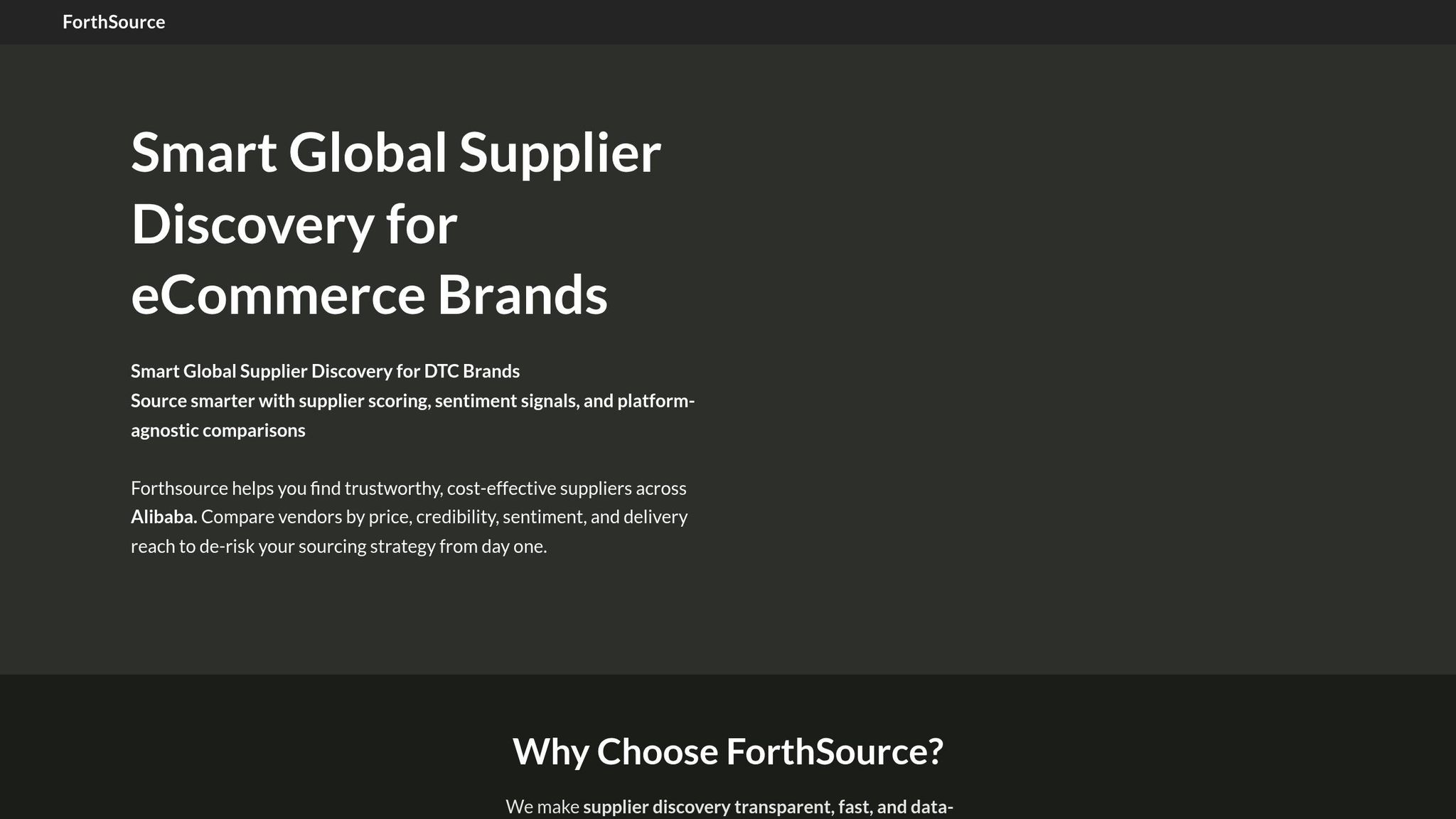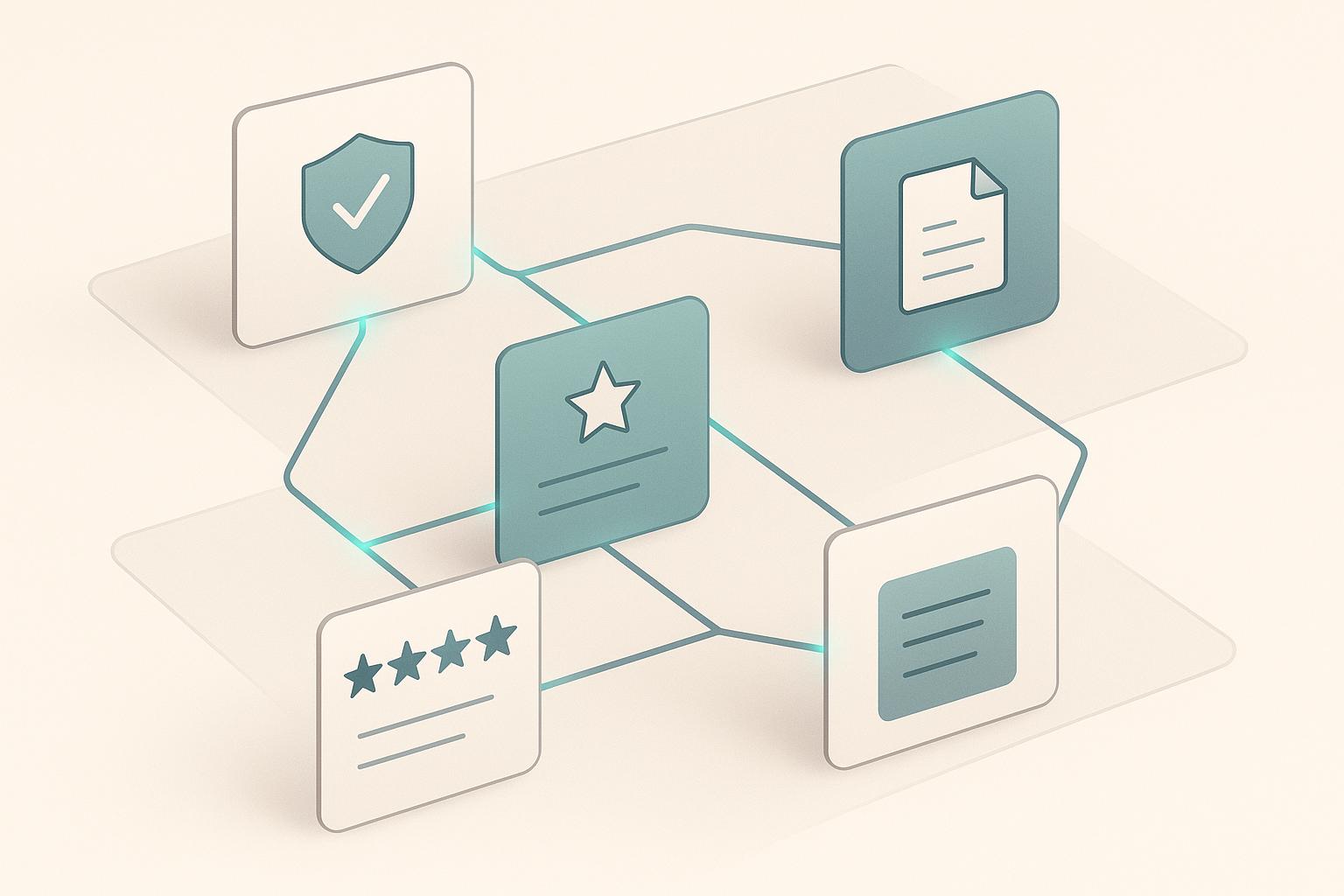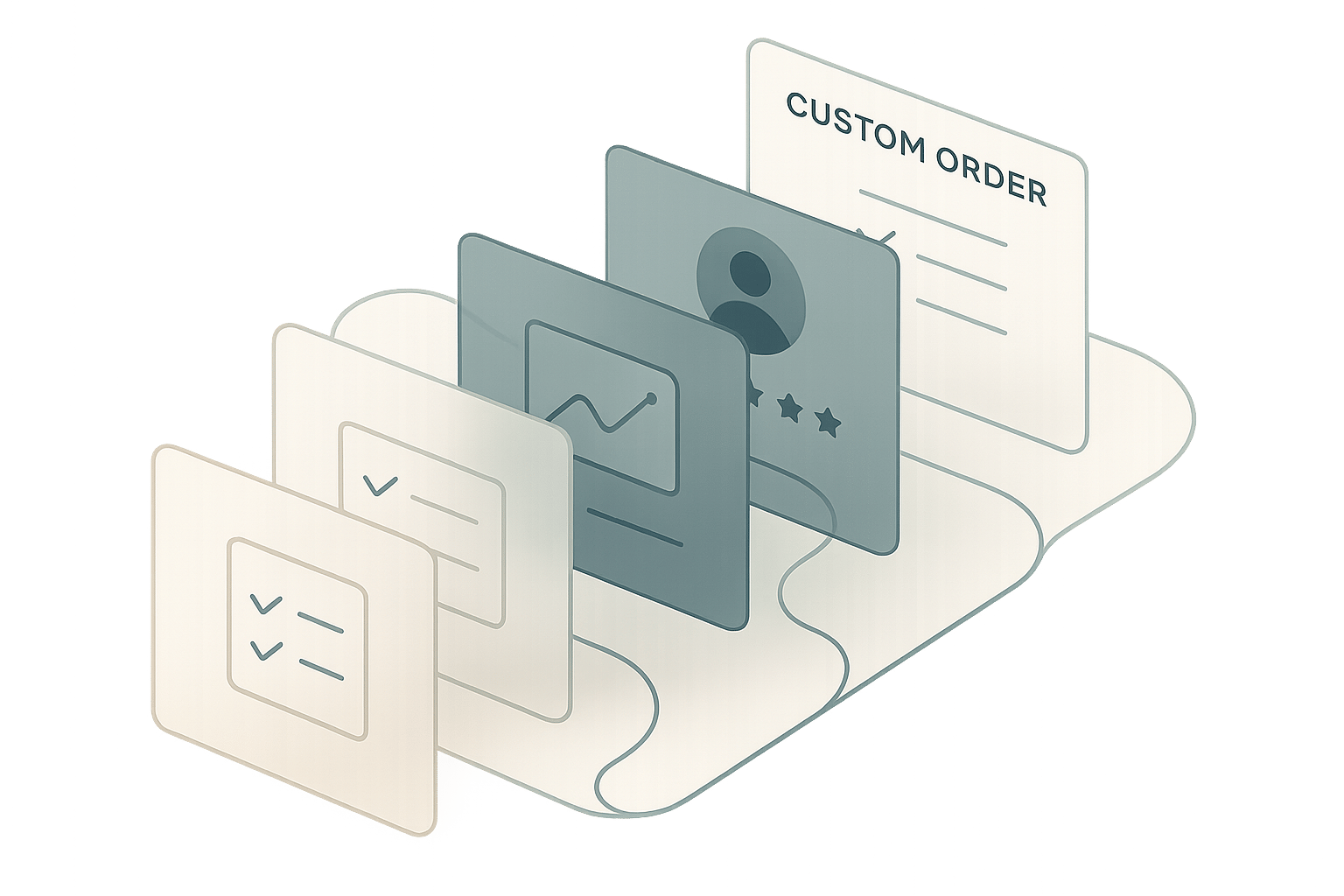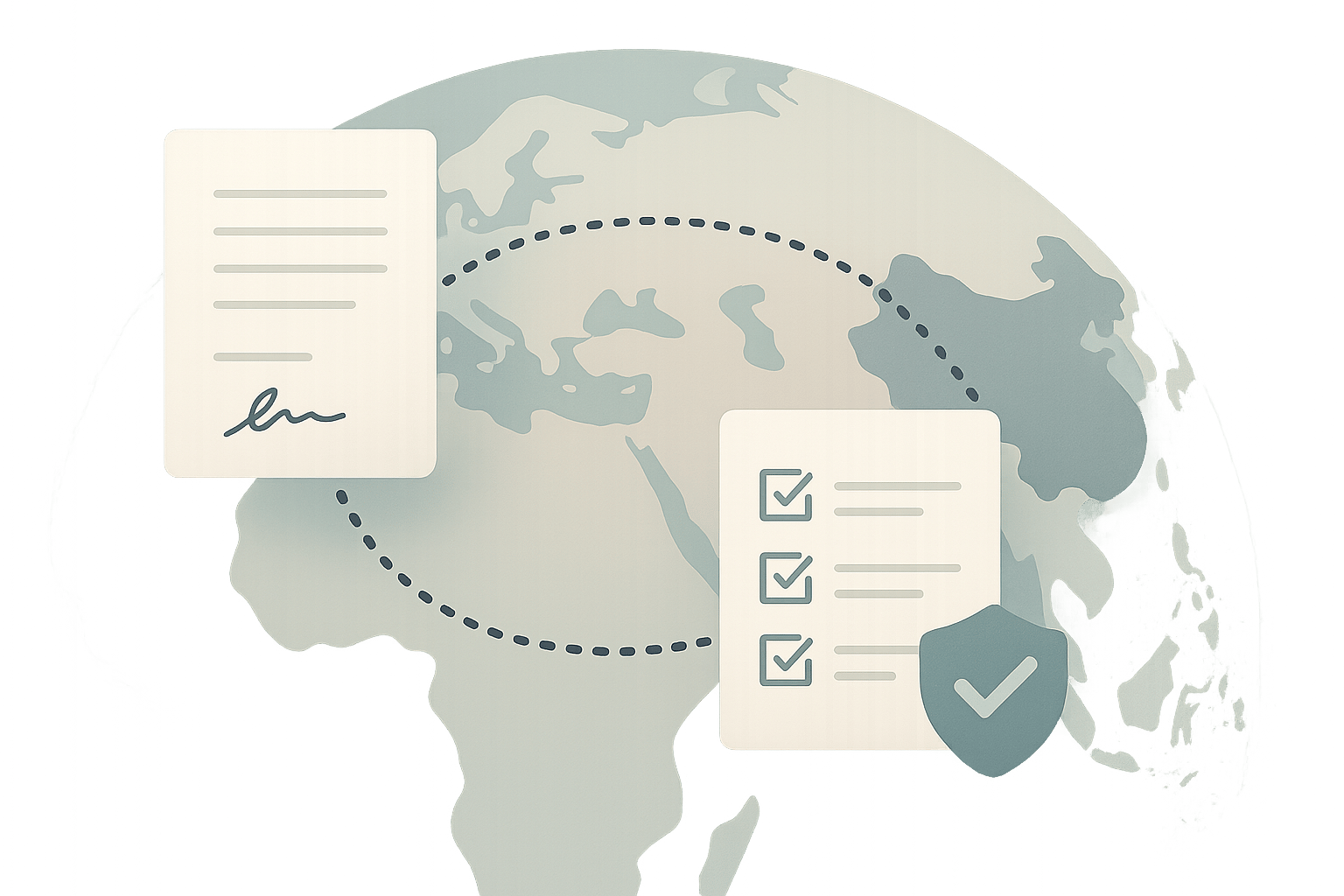Supplier risk assessment is about identifying and addressing potential problems with your suppliers. Why does it matter? Because disruptions in your supply chain can cost millions. For example, 70% of companies faced supply chain issues in recent years, with each incident averaging $2.5 million in losses.
Here’s how you can evaluate supplier risks effectively:
- Financial Health: Check cash flow, debt levels, and credit reports. Warning signs include late payments or reluctance to share financial data.
- Legal Compliance: Ensure suppliers follow laws and industry standards. Look for valid licenses, certifications, and a clean litigation history.
- Product Quality: Assess quality control processes, defect rates, and customer feedback. Consistent quality is critical for maintaining your brand’s reputation.
- Operational Capacity: Confirm suppliers can handle your demand, especially during peak times or emergencies. Evaluate their production capacity and backup plans.
- Ethical Practices: Verify labor conditions, environmental responsibilities, and anti-corruption policies. Consumers and regulators expect accountability.
Why Use a Checklist?
A checklist ensures thorough evaluations, consistent standards, and documentation for audits. It’s scalable as your business grows, helping you avoid costly mistakes.
Tools for Better Assessments
Platforms like ForthSource automate risk scoring by analyzing financial data, compliance records, and customer reviews. They save time and provide real-time updates, making it easier to monitor supplier performance.
Key Takeaways
- Use a structured checklist to evaluate risks in financial stability, compliance, quality, operations, and ethics.
- Document findings and regularly reassess suppliers to keep your supply chain reliable.
- Leverage tools like ForthSource for faster, data-driven assessments.
5 Strategies for Efficient Vendor Onboarding
Main Risk Categories to Evaluate
Evaluating supplier risks requires a structured approach that focuses on five main areas. Each one highlights potential challenges that could disrupt your supply chain. By understanding these categories, you can create a solid framework to safeguard your operations from unexpected issues. Here's what to consider:
Financial Stability
A supplier's financial health is critical to maintaining a dependable relationship. Financially unstable suppliers can suddenly go out of business, leaving you in a bind to find replacements and meet deadlines.
To assess this, request audited financial records from the past three years. Pay close attention to cash flow, debt-to-equity ratios, and profit margins. Negative cash flow or rising debt levels are clear red flags. Credit reports from agencies like Dun & Bradstreet can provide additional details, such as payment histories and any bankruptcy filings.
Warning signs include frequent late payments to their own vendors or hesitation to share financial documents. According to a 2024 UpGuard report, 63% of organizations faced supply chain disruptions in the last year, with financial instability being one of the top causes.
Legal and Regulatory Compliance
Non-compliance with legal and industry standards can lead to fines, product recalls, and damage to your reputation. Ensuring your suppliers meet all necessary regulations is non-negotiable.
Request proof of valid business licenses, industry-specific certifications, and compliance with applicable regulations. For U.S. importers, this might include FDA rules for food products, FTC guidelines for consumer goods, or CPSC safety standards for children's items.
Background checks can uncover a supplier's litigation history, regulatory violations, or sanctions. A problematic compliance record is a clear risk indicator. Tools like ForthSource can simplify this process by consolidating legal and compliance data, making it easier to identify trustworthy suppliers.
Product Quality and Reliability
The quality of a supplier’s products directly affects your brand and customer satisfaction. Poor-quality goods can result in returns, bad reviews, and a loss of trust.
Evaluate their quality control systems, including testing procedures, inspection methods, and systems for tracking defects. Look for certifications like ISO 9001, which reflect a commitment to maintaining quality standards. Review records of defect rates and customer complaints to gauge their reliability.
Request multiple samples from different production batches to check consistency. Independent third-party audits can also verify their claims and uncover potential issues that might not be immediately obvious.
It’s important to see how suppliers handle defects. Clear processes for addressing quality problems, along with warranties or guarantees, can help reduce risks tied to unreliable products.
Operational Capabilities
A supplier’s operational strength determines whether they can consistently meet your needs, especially during high-demand periods or unexpected disruptions.
Compare their maximum production capacity to your requirements, factoring in seasonal variations. Suppliers operating close to full capacity may struggle to accommodate growth or urgent orders. Assess their equipment and maintenance schedules - outdated machinery can slow production.
Resilience is key. Suppliers with diversified sourcing, backup facilities, and disaster recovery plans tend to perform better during crises like natural disasters or labor strikes. Reviewing their historical lead times can also provide insight into their efficiency and ability to scale.
Ethical Practices and ESG Factors
Environmental, social, and governance (ESG) considerations are no longer optional - they’re essential. Both consumers and regulators are paying closer attention to how companies source their products, making ethical practices a business priority.
Examine labor practices through certifications like SA8000 or audit reports that detail working conditions and wages. Suppliers unwilling to discuss labor standards or allow facility inspections should raise concerns.
Environmental responsibility involves evaluating waste management, energy use, and adherence to environmental laws. Many U.S. companies now require suppliers to meet sustainability goals or share data like carbon footprints, as violations can lead to supply chain disruptions and penalties.
Corporate governance is equally crucial. Look for transparency in business practices, clear anti-corruption policies, and ethical decision-making processes. Suppliers with unclear ownership, frequent management turnover, or reluctance to share basic business details may signal deeper issues.
Step-by-Step Supplier Risk Assessment Checklist
Taking a structured approach to supplier risk assessment helps you spot potential problems early and make smarter decisions. This five-step process ensures you evaluate suppliers consistently, avoiding costly mistakes.
Define Assessment Goals
Before diving into evaluations, set clear objectives. What are you trying to achieve? Your goals will shape which risks to prioritize and how in-depth your analysis should be.
For example, are you focusing on maintaining top-tier product quality for a premium brand, cutting costs to stay competitive, or meeting sustainability expectations for eco-conscious consumers? Each focus area requires attention to different risk factors. Industry-specific needs matter too - food companies must ensure FDA compliance, while electronics manufacturers need to meet FCC or CPSC standards.
Write down these goals and share them with your team. This ensures everyone is on the same page when assessing suppliers, creating a unified approach to building risk profiles.
Create Supplier Risk Profiles
A detailed risk profile is essential for comparing suppliers fairly. Include financial health, operational reliability, and compliance records as core indicators.
Go beyond the basics by factoring in reputation metrics like customer reviews, industry standing, and years in business. Modern tools can simplify this process by aggregating data - such as domain credibility, review sentiment, and pricing accuracy - into trust scores. These scores provide a quick, side-by-side comparison of suppliers.
Collect and Verify Information
Gathering accurate data is crucial. Use a mix of direct requests (like questionnaires) and independent checks (such as certification databases) to verify supplier claims.
Leverage technology to speed up data collection. Many platforms now pull real-time performance metrics from sources like marketplace ratings, sentiment analysis, and pricing benchmarks. A recent report shows that 78% of U.S. companies now use automated tools for supplier risk scoring, a jump from 54% in 2022.
Cross-check information from multiple sources to ensure accuracy. For instance, if a supplier claims excellent customer service but has poor reviews on verified platforms, that’s a warning sign worth investigating.
Assign Risk Scores
Once you’ve collected the data, assign risk scores based on clear, weighted criteria. Use a scoring matrix with a 1-10 scale, where 10 indicates the lowest risk.
Weight the categories according to your goals. If product quality is your top concern, it might account for 40% of the score, while cost factors contribute only 15%. Use visual aids like color-coded risk levels for clarity - green for low risk (8-10), yellow for medium risk (5-7), orange for high risk (3-4), and red for extreme risk (1-2).
Document the scoring process so everyone on your team applies the criteria consistently. Once the scores are finalized, record your findings for review.
Document and Approve Findings
Compile your findings, including risk scores and supporting evidence, in a standardized report. Share these with stakeholders for approval and set review schedules based on the supplier’s risk level.
Establish clear thresholds for action. For instance, suppliers scoring below 6/10 might require further checks, while those below 4/10 could be rejected outright. Keep detailed records in a centralized system for future reference.
Schedule periodic reviews based on risk levels - high-risk suppliers may need quarterly evaluations, while low-risk ones might only require annual check-ins. This documentation becomes part of an ongoing risk management process, ensuring your supplier relationships remain reliable over time.
sbb-itb-633367f
Tools and Methods for Risk Assessment
Modern tools have reshaped supplier risk assessment by leveraging real-time, data-driven insights. These advancements are at the core of platforms like ForthSource, which combines automation with up-to-the-minute data to simplify the evaluation process.
Using ForthSource for Risk Assessment

ForthSource makes supplier risk evaluation easier with its unique composite scoring system. By pulling data from over 50 platforms - including Alibaba - it evaluates key factors like pricing, domain credibility, WeChat activity, and legal compliance. This data is then distilled into a single, easy-to-read trust score.
Instead of juggling multiple sources to check a supplier's financial health, legal records, and customer feedback, ForthSource does the heavy lifting for you. It consolidates all these metrics into one place, presented in USD pricing and familiar U.S. formats, saving time and reducing complexity.
One standout feature is its sentiment analysis tool. By analyzing verified reviews from platforms like Google Reviews and Trustpilot, it helps identify fake ratings and unreliable feedback. This is especially useful for gauging supplier credibility, as it provides region-specific insights and verified public sentiment data.
ForthSource also supports ongoing risk management. Features like saved searches, supplier tracking, and historical records allow you to build a comprehensive supplier playbook over time. This makes future evaluations faster and more efficient.
Automated Risk Scoring Systems
Automated platforms have revolutionized supplier risk assessment with real-time analytics and continuous monitoring. These systems pull data from multiple sources, using algorithms to create dynamic risk scores that update as new information becomes available.
The biggest advantage? Data consistency. Unlike manual assessments, which can be influenced by bias or incomplete information, automated tools process massive amounts of data objectively. They evaluate financial indicators, compliance records, quality metrics, and operational performance, weighting these factors based on your specific criteria.
Modern systems also offer visual reports and alert mechanisms. If a supplier's risk profile changes - due to financial trouble, compliance violations, or quality issues - the system flags it immediately. This proactive approach helps you address problems before they disrupt your supply chain.
Scalability is another key benefit. As your supplier network grows, automated systems maintain the same level of thoroughness without requiring additional staff. This ensures every supplier, big or small, gets the same level of scrutiny.
Manual vs. Automated Assessment
While automation delivers speed and scalability, there are times when manual evaluation is the better choice. Knowing when to use each approach is critical for an effective risk assessment strategy.
| Aspect | Manual Assessment | Automated Assessment (e.g., ForthSource) |
|---|---|---|
| Speed | Time-consuming | Fast, real-time results |
| Accuracy | Prone to human error | Consistent, data-driven analysis |
| Scalability | Limited by staff availability | Scales easily across large supplier bases |
| Cost | Higher labor costs over time | Lower costs after initial setup |
| Compliance Evidence | Hard to document | Provides audit-ready records |
| Continuous Monitoring | Requires manual scheduling | Automated and ongoing |
Manual methods are ideal for one-time evaluations or unique situations requiring human judgment. They’re also practical for smaller operations with fewer suppliers. However, as your supplier base grows or frequent reassessments become necessary, manual processes can quickly become inefficient.
Automated platforms, on the other hand, shine in environments where speed, consistency, and scalability are crucial. They’re particularly useful for companies managing large supplier networks, needing audit-ready documentation, or operating in fast-changing markets.
For most organizations, a blended approach works best. Use automated systems for initial screenings and continuous monitoring, then rely on manual reviews for critical suppliers or when flagged issues arise. This hybrid strategy combines the efficiency of automation with the nuanced judgment of human oversight.
When deciding between these methods, consider your company’s size, supplier volume, and regulatory needs. For growing businesses, automated systems often provide the backbone of effective risk management, while manual assessments remain a valuable tool for special cases.
Continuous Monitoring and Risk Management
Once initial risk profiles are established, the work doesn’t stop there. Keeping an eye on your suppliers is a continuous process - an early warning system to spot potential issues and a safeguard against supply chain disruptions.
The problem? Many businesses still rely on outdated methods. According to a Deloitte survey, while 87% of organizations review critical suppliers at least once a year, only 32% use real-time or continuous monitoring systems. This gap leaves companies exposed to risks that can crop up between scheduled reviews.
Keeping Tabs on Performance
Tracking performance over time is key to catching problems before they snowball. Metrics like on-time delivery, defect rates, financial health, compliance, and customer complaints are the foundation of any monitoring system.
For example, monitoring defect rates monthly and comparing them to industry standards can reveal brewing quality issues. If defect rates suddenly spike, it’s often a sign of trouble ahead - giving you a chance to step in before customer complaints escalate. Similarly, financial indicators like a drop in credit scores or delayed payments can signal instability long before it becomes a crisis.
Platforms like ForthSource take monitoring a step further by gathering real-time data on supplier performance and reliability. They also pull sentiment signals from sources like Google Reviews and Trustpilot, giving a fuller picture of both operational performance and market perception - something traditional methods often overlook.
ForthSource also tracks trends in domain credibility and pricing accuracy. For instance, if a supplier’s pricing becomes erratic or their data starts to lack detail, these shifts could point to operational challenges or changing priorities.
To make it easier to manage, supplier risk scorecards act as dashboards that summarize ongoing monitoring efforts. These scorecards use color-coded risk levels - green for low risk, red for high risk - and combine performance, compliance, and financial data into a single view. This makes it simple to spot which suppliers need immediate attention, helping you make informed decisions about risk reduction or contract renewals.
When deviations are identified, quick action is key to minimizing risks.
Addressing Risks Head-On
When monitoring uncovers unacceptable risks, swift and decisive action is critical. Depending on the issue, you might need to implement corrective measures, renegotiate contracts, increase oversight, or even terminate the partnership.
For example, if a supplier’s financial stability weakens, you could require additional guarantees, request more frequent financial updates, or start qualifying backup suppliers. Compliance failures might call for retraining, process adjustments, or third-party audits with clear timelines and success criteria.
Keeping a centralized incident log is essential for documenting and resolving issues. Each risk event should be recorded with detailed information about its nature, impact, and resolution. Not only does this create audit-ready evidence of your risk management efforts, but it also helps identify recurring issues across suppliers, guiding future risk strategies.
Clear escalation protocols are vital to ensure no issue is overlooked. For instance, if a supplier fails a compliance audit, the incident should be logged, corrective actions assigned with deadlines, and progress tracked until it’s resolved. Reviewing these logs regularly can reveal patterns that may require tighter screening processes or adjustments to contracts.
While termination is a last resort, it’s sometimes unavoidable. Serious legal violations, major quality failures, or fundamental changes in a supplier’s business model might make ending the relationship necessary. Having pre-qualified backup suppliers ensures smoother transitions when such decisions are made.
Reassessing Regularly
Suppliers aren’t static - financial conditions shift, regulations evolve, and operational capacities change. Regular reassessments keep risk profiles accurate and up to date.
For most suppliers, an annual review is sufficient. However, for high-risk or critical suppliers, more frequent checks - such as quarterly reviews - are often necessary, especially if they represent a significant portion of your business or operate in volatile industries.
Certain triggers demand immediate reassessment, regardless of the regular schedule. Events like changes in ownership, major financial developments, new regulatory requirements, or repeated performance issues call for a fresh look. For example, if a supplier’s credit rating drops suddenly or new regulations are introduced, it’s time to reevaluate their risk profile.
ForthSource’s historical tracking features make this process easier by maintaining detailed records of supplier performance over time. This historical data helps identify trends and shifts that might not be obvious in one-off evaluations, enabling better decision-making and adaptability.
The move toward automated, real-time monitoring is reshaping supplier risk management. Tools that integrate data from financial, legal, and operational sources provide a continuously updated, comprehensive view of supplier risks.
Supplier risk is no longer just an operational concern - it’s now a strategic priority at the board level. Regulators, auditors, and executives increasingly expect companies to provide audit-ready documentation of their risk management efforts. Continuous monitoring and detailed records are now essential for safeguarding supplier performance over the long term.
Conclusion and Key Takeaways
Supplier risk assessment is more than just a box to check - it's a critical part of building a resilient business. With 87% of organizations experiencing disruptions from third-party suppliers and U.S. companies facing an average of $184 million annually in disruption costs, taking a systematic approach is no longer optional.
Using a structured checklist turns what could be a chaotic process into one that's organized and repeatable. Instead of merely meeting compliance requirements, this approach dives deeper into assessing financial health, legal compliance, product quality, operational strength, and ethical practices - helping you mitigate risks effectively.
But supplier risk assessment isn't a one-and-done task. It's an ongoing effort that needs to adjust to changing market dynamics and new regulations. Regular reassessments and continuous monitoring keep your risk profiles up-to-date, ensuring your evaluations remain as reliable as your initial reviews.
Technology is playing a significant role in simplifying this process. Tools like ForthSource streamline supplier evaluations by gathering data and applying scoring systems that factor in pricing, credibility, and legal compliance. These platforms help you identify reliable suppliers faster, reduce risks, and eliminate unnecessary middlemen or hidden fees.
Leading companies combine structured processes with smart technology to strengthen their supply chains. By consistently evaluating suppliers, documenting results, and leveraging real-time data for ongoing monitoring, you're not just reducing risks - you’re laying the groundwork for sustainable growth and operational success.
FAQs
What steps can businesses take to continuously monitor supplier risks and avoid disruptions?
To keep a close eye on supplier risks and avoid disruptions, businesses should utilize tools that offer real-time insights into supplier performance and trustworthiness. Platforms like ForthSource make this possible by providing a proprietary scoring system that evaluates suppliers using factors such as pricing, credibility, and legal history.
This method enables companies to make smarter sourcing decisions, identify dependable suppliers, and address risks tied to financial stability, compliance issues, or product quality. Ongoing monitoring helps spot potential problems early, ensuring operations run smoothly and the supply chain stays strong.
What tools can simplify the process of assessing and managing supplier risks?
ForthSource is a smart platform built to make supplier risk assessment and management easier. It uses a unique scoring system to evaluate suppliers based on key factors like pricing, reliability, and performance data, helping you make well-informed decisions faster.
The platform pulls supplier data from various sources and delivers real-time insights into critical trust indicators, such as legal compliance and product quality. This allows businesses to identify dependable, cost-efficient suppliers without relying on middlemen or dealing with hidden costs.
With ForthSource, you can simplify your supplier evaluation process, minimize risks, and confidently bring on reliable partners.
Why should ethical practices and ESG factors be included in supplier risk assessments?
Incorporating ethical practices and Environmental, Social, and Governance (ESG) factors into supplier risk assessments plays a key role in promoting responsible and sustainable business operations. These factors help pinpoint suppliers who share your values, adhere to regulations, and steer clear of risks tied to unethical behavior.
Evaluating ESG criteria can help you avoid challenges like environmental violations, labor exploitation, or damage to your reputation. Choosing suppliers with strong ESG performance not only contributes to steady business growth but also strengthens trust with customers and stakeholders who increasingly prioritize ethical and sustainable practices.


